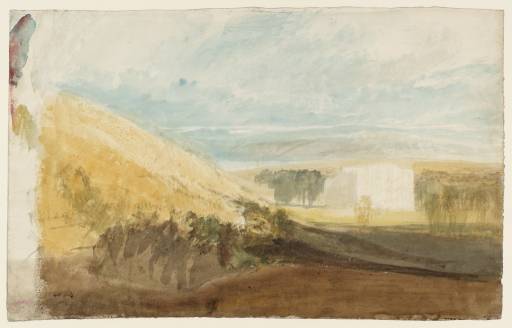Joseph Mallord William Turner Hylton Castle c.1817
Joseph Mallord William Turner,
Hylton Castle
c.1817
Joseph Mallord William Turner 1775–1851
Hylton Castle c.1817
D17206
Turner Bequest CXCVII P
Turner Bequest CXCVII P
Gouache and watercolour on white wove paper, 306 x 483 mm
Inscribed in red ink ‘CXCVII–P’ bottom left
Stamped in black ‘CXCVII–P’ bottom right
Inscribed in red ink ‘CXCVII–P’ bottom left
Stamped in black ‘CXCVII–P’ bottom right
Accepted by the nation as part of the Turner Bequest 1856
Exhibition history
1952
Turner Watercolours for the Huntington Art Gallery, Huntington Art Gallery, San Marino, California, January–March 1952 (8).
1979
Turner and the Country House View Tradition: Watercolours and Sketches from the Turner Bequest Loaned by the British Museum, Tate Gallery, London, January–June 1979 (no catalogue).
1983
J.M.W. Turner, à l’occasion du cinquantième anniversaire du British Council, Galeries nationales du Grand Palais, Paris, October 1983–January 1984 (130).
1987
Watercolours from the Turner Bequest, Tate Gallery, London, April–October 1987 (no catalogue).
1990
The Third Decade: Turner Watercolours 1810–1820, Tate Gallery, London, January–April 1990 (33).
1993
J.M.W. Turner 1775–1851: Impressions de Gran Bretanya i el Continent Europeu / Impresiones de Gran Bretaña y el Continente Europeo, Centre Cultural de la Fundació ”la Caixa”, Barcelona, September–November 1993, Sala de Exposiciones de la Fundación ”la Caixa”, Madrid, November 1993–January 1994 (28, reproduced in colour).
1994
J.M.W. Turner 1775–1851: Aquarelles et Dessins du Legs Turner: Collection de la Tate Gallery, Londres / Watercolours and Drawings from the Turner Bequest: Collection from the Tate Gallery, London, Palais des Beaux-Arts de Charleroi, September–December 1994 (28, reproduced in colour).
2007
Hockney on Turner Watercolours, Tate Britain, London, June 2007–February 2008 (no number).
.
References
1909
A.J. Finberg, A Complete Inventory of the Drawings of the Turner Bequest, London 1909, vol.I, p.603, CXCVII P, as ‘Study for drawing of “Hilton Castle.”.
1979
Andrew Wilton, J.M.W. Turner: His Life and Work, Fribourg 1979, p.364 under no.556.
1983
John Gage, Jerrold Ziff, Nicholas Alfrey and others, J.M.W. Turner, à l’occasion du cinquantième anniversaire du British Council, exhibition catalogue, Galeries nationales du Grand Palais, Paris 1983, pp.20, 207 no.130, p.210 under no.133.
1990
Diane Perkins, The Third Decade: Turner Watercolours 1810–1820, exhibition catalogue, Tate Gallery, London 1990, pp.33,41 no.26, under no.27.
1993
Ian Warrell, J.M.W. Turner 1775–1851: Impressions de Gran Bretanya i el Continent Europeu / Impresiones de Gran Bretaña y el Continente Europeo, exhibition catalogue, Centre Cultural de la Fundació ”la Caixa”, Barcelona 1993, pp.108, 278 no.28.
1994
Ian Warrell, J.M.W. Turner 1775–1851: Aquarelles et Dessins du Legs Turner: Collection de la Tate Gallery, Londres / Watercolours and Drawings from the Turner Bequest: Collection from the Tate Gallery, London, exhibition catalogue, Palais des Beaux-Arts de Charleroi 1994, pp.110–111 no.28, reproduced in colour.
2007
David Blayney Brown, Turner Watercolours, exhibition catalogue, Tate Britain, London 2007, p.55, reproduced.
Turner visited Hylton Castle near Sunderland towards the end of October 1817.1 Its owner, the 10th Earl of Strathmore, commissioned a watercolour of the house to be engraved for publication. This lively ‘colour beginning’ lays out the key composition and colour relationships present in Turner’s finished landscape watercolour (private collection).2 It was engraved by Samuel Rawle (1771–1860) and included as Hylton Castle, Co. of Durham in the second volume of Robert Surtees’s The History and Antiquities of the County Palatine of Durham (1820). For information about the project, see the Introduction to this section.
The foreground is dominated by the hill to the left, the warm brownish yellow paint contrasting against the blue and white of the sky. As in some of his History of Richmondshire colour studies, Turner used a dry brush technique to quickly denote plant textures, with no suggestion of the figures we see in the finished composition presented within the colour study. The white of the paper is used to indicate the castle itself. The composition of both the colour study and the finished watercolour largely follow that of a pencil drawing of 1817 in Turner’s Raby sketchbook (Tate D12276; Turner Bequest CLVI 10).
Technical notes:
A dry brush technique has been used in the hillside. A thumbprint is visible within the paint near the centre. There is a series of colour tests in the upper left of the sheet.
Verso:
Blank; inscribed in pencil ‘32’ centre, and ‘P’ bottom right; stamped in black ‘CXCVII–P’ bottom left, and with Turner Bequest monogram bottom left.
Elizabeth Jacklin
September 2016
How to cite
Elizabeth Jacklin, ‘Hylton Castle c.1817 by Joseph Mallord William Turner’, catalogue entry, September 2016, in David Blayney Brown (ed.), J.M.W. Turner: Sketchbooks, Drawings and Watercolours, Tate Research Publication, July 2017, https://www

